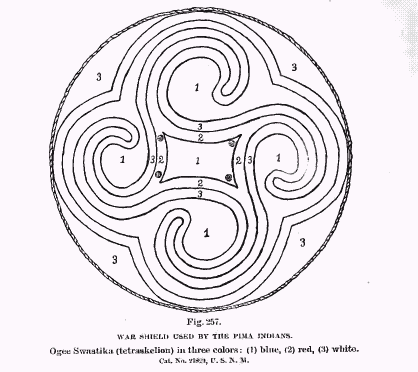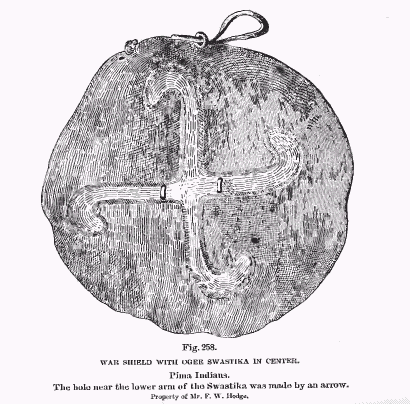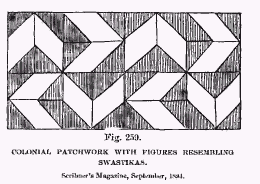|
The Swastika
Dispersion of the Swastika
Page 92
know not whether it is intended
as a religious symbol, a charm of blessing, or good luck, or whether it
is only an ornament. We do not know whether it has any hidden, mysterious,
or symbolic meaning; but there it is, a prehistoric or Oriental Swastika
in all its purity and simplicity, appearing in one of the mystic ceremonies
of the aborigines in the great American desert in the interior of the
North American Continent.
 The
Pimas. --- The U. S. National Museum possesses a shield (Cat. No.
27829) of bull hide, made by the Pima Indians. It is about 20 inches in
diameter, and bears upon its face an ogee Swastika (tetraskelion), the
ends bent to the right. The body and each arm is divided longitudinally
into three stripes or bands indicated by colors, blue, red, and white,
arranged alternately. The exterior part of the shield has a white ground,
while the interior or center has a blue ground. This shield (fig. 257)
is almost an exact reproduction of the Swastika from Mycenæ (fig.
161), from Ireland (fig. 216),
and from Scandinavia (figs. 209
and 210). Fig. 258
The
Pimas. --- The U. S. National Museum possesses a shield (Cat. No.
27829) of bull hide, made by the Pima Indians. It is about 20 inches in
diameter, and bears upon its face an ogee Swastika (tetraskelion), the
ends bent to the right. The body and each arm is divided longitudinally
into three stripes or bands indicated by colors, blue, red, and white,
arranged alternately. The exterior part of the shield has a white ground,
while the interior or center has a blue ground. This shield (fig. 257)
is almost an exact reproduction of the Swastika from Mycenæ (fig.
161), from Ireland (fig. 216),
and from Scandinavia (figs. 209
and 210). Fig. 258
 shows another Pima shield
of the same type. Its Swastika is, however, painted with a single or possibly
a mixture of two, red and white. It is ogee, and the ends bend to the
left. This shield is the property of Mr. F. W. Hodge, of the Buereau of
Ethnology. He obtained it from a Pima Indian in Arizona, who assured him
that the hole at the end of the lower arm of the Swastika was made by
an arrow shot at him by an Indian enemy.
shows another Pima shield
of the same type. Its Swastika is, however, painted with a single or possibly
a mixture of two, red and white. It is ogee, and the ends bend to the
left. This shield is the property of Mr. F. W. Hodge, of the Buereau of
Ethnology. He obtained it from a Pima Indian in Arizona, who assured him
that the hole at the end of the lower arm of the Swastika was made by
an arrow shot at him by an Indian enemy.
Colonial Patchwork.
In
Scribner's Magazine for September, 1894, under the title of "Tapestry
in the New World," one of our popular writers has described, with
many illustrations, the bedquilt patterns of our grandmothers' time. One
of these she interprets as the  Swastika. This is, however, believed to be forced. The pattern in question
is made of patches in the form of rhomboids and right-angled triangles
sewed and grouped somewhat in the form of the Swastika (fig. 259). It
is an invented combination of patchwork which formed a new pattern, and
while it bears a slight resemblance to the Swastika, lacks its essential
elements. It was not a symbol, and represents no idea beyond that of a
pretty pattern. It stood for nothing sacred, nor for benediction, blessing,
nor good luck. It was but an ornamental pattern which fortuitously had
the resemblance of Swastika. It was not even in the form of a cross. The
difference between it and the Swastika is about the same there would be
between the idle and thoughtless boy who sporadically draws the
Swastika. This is, however, believed to be forced. The pattern in question
is made of patches in the form of rhomboids and right-angled triangles
sewed and grouped somewhat in the form of the Swastika (fig. 259). It
is an invented combination of patchwork which formed a new pattern, and
while it bears a slight resemblance to the Swastika, lacks its essential
elements. It was not a symbol, and represents no idea beyond that of a
pretty pattern. It stood for nothing sacred, nor for benediction, blessing,
nor good luck. It was but an ornamental pattern which fortuitously had
the resemblance of Swastika. It was not even in the form of a cross. The
difference between it and the Swastika is about the same there would be
between the idle and thoughtless boy who sporadically draws the
<< Previous Page
Next
Page >>
© 2004-2007 Northvegr.
Most of the material on this site is in the public domain. However, many people have worked very hard to bring these texts to you so if you do use the work, we would appreciate it if you could give credit to both the Northvegr site and to the individuals who worked to bring you these texts. A small number of texts are copyrighted and cannot be used without the author's permission. Any text that is copyrighted will have a clear notation of such on the main index page for that text. Inquiries
can be sent to info@northvegr.org.
Northvegr™ and the Northvegr symbol are trademarks and service marks
of the Northvegr Foundation.
|
> Northvegr™ Foundation
>> About Northvegr Foundation
>> What's New
>> Contact Info
>> Link to Us
>> E-mail Updates
>> Links
>> Mailing Lists
>> Statement of Purpose
>> Socio-Political Stance
>> Donate
> The Vík - Online Store
>> More Norse Merchandise
> Advertise With Us
> Heithni
>> Books & Articles
>> Trúlög
>> Sögumál
>>
Heithinn Date Calculator
>> Recommended Reading
>>
The 30 Northern Virtues
> Recommended Heithinn Faith Organizations
>> Alfaleith.org
> NESP
>> Transcribe Texts
>> Translate Texts
>> HTML Coding
>> PDF Construction
> N. European Studies
>> Texts
>> Texts in PDF Format
>> NESP Reviews
>> Germanic Sources
>> Roman Scandinavia
>> Maps
> Language Resources
>> Zoëga Old Icelandic Dict.
>> Cleasby-Vigfusson Dictionary
>> Sweet's Old Icelandic Primer
>> Old Icelandic Grammar
>> Holy Language Lexicon
>> Old English Lexicon
>> Gothic Grammar Project
>> Old English Project
>> Language Resources
> Northern Family
>> Northern Fairy Tales
>> Norse-ery Rhymes
>>
Children's Books/Links
>> Tafl
>> Northern Recipes
>> Kubb
> Other Sections
>> The Holy Fylfot
>> Tradition Roots

Please Visit Our Sponsors
- Référencement
- Alfaleith.org - Heithni, Viðartrú
- Odin's Journey
- Baman - Iceland/Aboriginal Australia
- Biker's Booty
- Création site Internet Paris
- Pagan T-shirts
- Appartements
- Chalets au Québec
- Logo Designers
- Web Design
- Appartements Montreal
- Espace Bureau Montreal
- London Tours
- Spanish Property Legal Advice
- Multi Pret Hypotheque
- Company Logo Design
- Wiccan T-shirts
- Art Gallery, Painting artists
- free logo design reviews
- Heathen, Heathenism, Norse Pagan
- Logo design by LogoBee
- Pagan Shirts
- Norse Pagan Religion
- Triumph, BSA, Norton, Euro Motorcycles - Accessories
- Logo Maker
- Logo Design - Business Logos, Inc.
- Logo Design - Logo Maker
- Create A Website
- Wiccan Shirts
- Mortgages
- Multi-Prêts Hypothèques
- Viking T-shirts
- Hewlett Packard Ink Cartridges
- Indian Recipes
- Logo Design London
- Logo Design
- Logo Design UK
- Subvention et financement PME
- Heathen T-shirts
- Medical Alert, Emergency response
- orlando hotels
- Slot Machines for Vikings
- Norse Pagan Clothing and Merchandise
- New Homes
- Branding Irons
- Bachelor Degree Online
- Online Degree
- College Degree
- Heathen, Viking and Norse Texts
- Création site Internet
- Montreal Web Design
- Free Dish Network Satellite TV
- Discount ink cartridge & laser cartridge
- DUI Lawyers & DWI Attorneys
- Promotional Products
- Ready-Made Company Logos
- Canadian Art Dealer
- Best CD Rates
- Laser Toner Cartridge
- Logotyper & Grafiska Profilprogram
- Banner Design
- Custom Logo Design
Web site design and coding by Golden Boar Creations
|
|




 Swastika. This is, however, believed to be forced. The pattern in question
is made of patches in the form of rhomboids and right-angled triangles
sewed and grouped somewhat in the form of the Swastika (fig. 259). It
is an invented combination of patchwork which formed a new pattern, and
while it bears a slight resemblance to the Swastika, lacks its essential
elements. It was not a symbol, and represents no idea beyond that of a
pretty pattern. It stood for nothing sacred, nor for benediction, blessing,
nor good luck. It was but an ornamental pattern which fortuitously had
the resemblance of Swastika. It was not even in the form of a cross. The
difference between it and the Swastika is about the same there would be
between the idle and thoughtless boy who sporadically draws the
Swastika. This is, however, believed to be forced. The pattern in question
is made of patches in the form of rhomboids and right-angled triangles
sewed and grouped somewhat in the form of the Swastika (fig. 259). It
is an invented combination of patchwork which formed a new pattern, and
while it bears a slight resemblance to the Swastika, lacks its essential
elements. It was not a symbol, and represents no idea beyond that of a
pretty pattern. It stood for nothing sacred, nor for benediction, blessing,
nor good luck. It was but an ornamental pattern which fortuitously had
the resemblance of Swastika. It was not even in the form of a cross. The
difference between it and the Swastika is about the same there would be
between the idle and thoughtless boy who sporadically draws the 